An Analytic Method for Power System Fault Diagnosis Employing Topology Description
Abstract
1. Introduction
- (1)
- Based on the incident matrix, the topology description of the power system is established to represent the correlation between the sections and the protective devices, and the expected states of the protection devices can be analyzed by simple matrix operations.
- (2)
- Considering both the operating logic error and the communication error of the protective devices, the improved objective function of the analytic model is constructed, which can adapt to power systems with different structure or connections.
- (3)
- The optimized solution can distinguish the true hypothesis from the false ones with better fault tolerance, and the diagnosis result is helpful to evaluate the abnormal operation of protective device and the communication error of alarm signals.
2. Topology Analyses of Power System
2.1. Topology Description of Power System
2.2. Expected States of the Protective Devices
3. The Analytic Model for Fault Diagnosis Employing Topology Description
3.1. Objective Function of the Analytic Model
3.2. Determination of the Corrective Matrices
3.3. Adaptability to Special Sections and Connection Modes
3.4. Framework of the Fault Diagnosis Method
4. Case Studies
4.1. Test System #1
4.2. Test System 2
5. Discussion
6. Conclusions
Author Contributions
Funding
Conflicts of Interest
References
- Ferreira, V.H.; Zanghi, R.; Fortes, M.Z.; Sotelo, G.G.; Silva, R.B.M.; Souza, J.C.S.; Guimaraes, C.H.C.; Gomes, S. A survey on intelligent system application to fault diagnosis in electric power system transmission lines. Electr. Power Syst. Res. 2016, 136, 135–153. [Google Scholar] [CrossRef]
- Vale, Z.A.; Moura, A.M.E. An expert system with temporal reasoning for alarm processing in power system control centers. IEEE Trans. Power Syst. 1993, 8, 1307–1314. [Google Scholar] [CrossRef]
- Cho, H.J.; Park, J.K. An expert system for fault section diagnosis of power systems using fuzzy relations. IEEE Trans. Power Syst. 1997, 12, 342–347. [Google Scholar]
- Lee, H.J.; Park, D.Y.; Ahn, B.S.; Park, Y.M.; Park, J.K.; Venkata, S.S. A fuzzy expert system for the integrated fault diagnosis. IEEE Trans. Power Deliv. 2000, 15, 833–838. [Google Scholar]
- Bi, T.S.; Yan, Z.; Wen, F.S.; Ni, Y.X.; Shen, C.M.; Wu, F.F.; Yang, Q.X. On-line fault section estimation in power systems with radial basis function neural network. Int. J. Electr. Power Energy Syst. 2002, 24, 321–328. [Google Scholar] [CrossRef]
- Cardoso, G.; Rolim, J.G.; Zurn, H.H. Application of neural-network modules to electric power system fault section estimation. IEEE Trans. Power Deliv. 2004, 19, 1034–1041. [Google Scholar] [CrossRef]
- Thukaram, D.; Khincha, H.P.; Vijaynarasimha, H.P. Artificial neural network and support vector machine approach for locating faults in radial distribution systems. IEEE Trans. Power Deliv. 2005, 20, 710–721. [Google Scholar] [CrossRef]
- Min, S.W.; Sohn, J.M.; Park, J.K.; Kim, K.H. Adaptive fault section estimation using matrix representation with fuzzy relations. IEEE Trans. Power Syst. 2004, 19, 842–848. [Google Scholar] [CrossRef]
- Chen, W.H. Online Fault Diagnosis for Power Transmission Networks Using Fuzzy Digraph Models. IEEE Trans. Power Deliv. 2012, 27, 688–698. [Google Scholar] [CrossRef]
- Hor, C.L.; Crossley, P.A.; Watson, S.J. Building knowledge for substation-based decision support using rough sets. IEEE Trans. Power Deliv. 2007, 22, 1372–1379. [Google Scholar] [CrossRef]
- Rawat, S.; Patel, A.; Celestino, J.; dos Santos, A.L.M. A dominance based rough set classification system for fault diagnosis in electrical smart grid environments. Artif. Intell. Rev. 2016, 46, 389–411. [Google Scholar] [CrossRef]
- Zhu, Y.L.; Huo, L.M.; Lu, J.L. Bayesian networks-based approach for power systems fault diagnosis. IEEE Trans. Power Deliv. 2006, 21, 634–639. [Google Scholar]
- Ricks, B.; Mengshoel, O.J. Diagnosis for uncertain, dynamic and hybrid domains using Bayesian networks and arithmetic circuits. Int. J. Approx. Reason. 2014, 55, 1207–1234. [Google Scholar] [CrossRef]
- Lin, S.; Chen, X.Y.; Wang, Q. Fault diagnosis model based on Bayesian network considering information uncertainty and its application in traction power supply system. IEEJ Trans. Electr. Electron. Eng. 2018, 13, 671–680. [Google Scholar] [CrossRef]
- Sun, J.; Qin, S.Y.; Song, Y.H. Fault diagnosis of Electric Power Systems based on Fuzzy Petri Nets. IEEE Trans. Power Syst. 2004, 19, 2053–2059. [Google Scholar] [CrossRef]
- Xu, L.; Kezunovic, M. Implementing Fuzzy Reasoning Petri-Nets for Fault Section Estimation. IEEE Trans. Power Deliv. 2008, 23, 676–685. [Google Scholar]
- Zhang, X.; Yue, S.; Zha, X.B. Method of power grid fault diagnosis using intuitionistic fuzzy Petri nets. IET Gener. Transm. Distrib. 2018, 12, 295–302. [Google Scholar] [CrossRef]
- Wen, F.S.; Chang, C.S. Probabilistic approach for fault-section estimation in power systems based on a refined genetic algorithm. IEE Proc.-Gener. Transm. Distrib. 1997, 144, 160–168. [Google Scholar] [CrossRef]
- Wen, F.S.; Chang, C.S. A tabu search approach to fault section estimation in power systems. Electr. Power Syst. Res. 1997, 40, 63–73. [Google Scholar] [CrossRef]
- Wen, F.S.; Chang, C.S. Possibilistic-diagnosis theory for fault-section estimation and state identification of unobserved protective relays using tabu-search method. IEE Proc.-Gener. Transm. Distrib. 1998, 145, 722–730. [Google Scholar] [CrossRef]
- Wen, F.S.; Chang, C.S.; Fu, W.H. New approach to alarm processing in power systems based on the set covering theory and a refined genetic algorithm. Electr. Mach. Power Syst. 1998, 26, 53–67. [Google Scholar] [CrossRef]
- Liu, Y.; Li, Y.; Cao, Y.J.; Guo, C.X. Forward and backward models for fault diagnosis based on parallel genetic algorithms. J. Zhejiang Univ.-Sci. A 2008, 9, 1420–1425. [Google Scholar] [CrossRef]
- Chang, C.S.; Tian, L.; Wen, F.S. A new approach to fault section estimation in power systems using Ant system. Electr. Power Syst. Res. 1999, 49, 63–70. [Google Scholar] [CrossRef]
- Huang, S.J. Application of immune-based optimization method for fault-section estimation in a distribution system. IEEE Trans. Power Deliv. 2002, 17, 779–784. [Google Scholar] [CrossRef]
- Leao, F.B.; Pereira, R.A.F.; Mantovani, J.R.S. Fault section estimation in electric power systems using an optimization immune algorithm. Electr. Power Syst. Res. 2010, 80, 1341–1352. [Google Scholar] [CrossRef]
- Huang, S.J.; Liu, X.Z.; Su, W.F.; Ou, T.C. Application of Enhanced Honey-Bee Mating Optimization Algorithm to Fault Section Estimation in Power Systems. IEEE Trans. Power Deliv. 2013, 28, 1944–1951. [Google Scholar] [CrossRef]
- Xiong, G.J.; Shi, D.Y.; Zhang, J.; Zhang, Y. A binary coded brain storm optimization for fault section diagnosis of power systems. Electr. Power Syst. Res. 2018, 163, 441–451. [Google Scholar] [CrossRef]
- Lin, X.N.; Ke, S.H.; Li, Z.T.; Weng, H.L.; Han, X.H. A Fault Diagnosis Method of Power Systems Based on Improved Objective Function and Genetic Algorithm-Tabu Search. IEEE Trans. Power Deliv. 2010, 25, 1268–1274. [Google Scholar] [CrossRef]
- Guo, W.X.; Wen, F.S.; Ledwich, G.; Liao, Z.W.; He, X.Z.; Liang, J.H. An Analytic Model for Fault Diagnosis in Power Systems Considering Malfunctions of Protective Relays and Circuit Breakers. IEEE Trans. Power Deliv. 2010, 25, 1393–1401. [Google Scholar] [CrossRef]
- Liu, D.B.; Gu, X.; Li, H. A Complete Analytic Model for Fault Diagnosis of Power Systems. Proc. CSEE 2011, 31, 85–92. [Google Scholar]
- Li, Z.X.; Yin, X.G.; Zhang, Z.; He, Z.Q. Wide-Area Protection Fault Identification Algorithm Based on Multi-Information Fusion. IEEE Trans. Power Deliv. 2013, 28, 1348–1355. [Google Scholar]
- Guo, W.X.; Wen, F.S.; Liao, Z.W.; Wei, L.H.; Xin, J.B. An Analytic Model-Based Approach for Power System Alarm Processing Employing Temporal Constraint Network. IEEE Trans. Power Deliv. 2010, 25, 2435–2447. [Google Scholar] [CrossRef]
- Guo, W.X.; Wen, F.S.; Ledwich, G.; Liao, Z.W.; He, X.Z.; Huang, J.S. A new analytic approach for power system fault diagnosis employing the temporal information of alarm messages. Int. J. Electr. Power Energy Syst. 2012, 43, 1204–1212. [Google Scholar] [CrossRef]
- Zhang, Y.; Chung, C.Y.; Wen, F.H.; Zhong, J.Y. An Analytic Model for Fault Diagnosis in Power Systems Utilizing Redundancy and Temporal Information of Alarm Messages. IEEE Trans. Power Syst. 2016, 31, 4877–4886. [Google Scholar] [CrossRef]
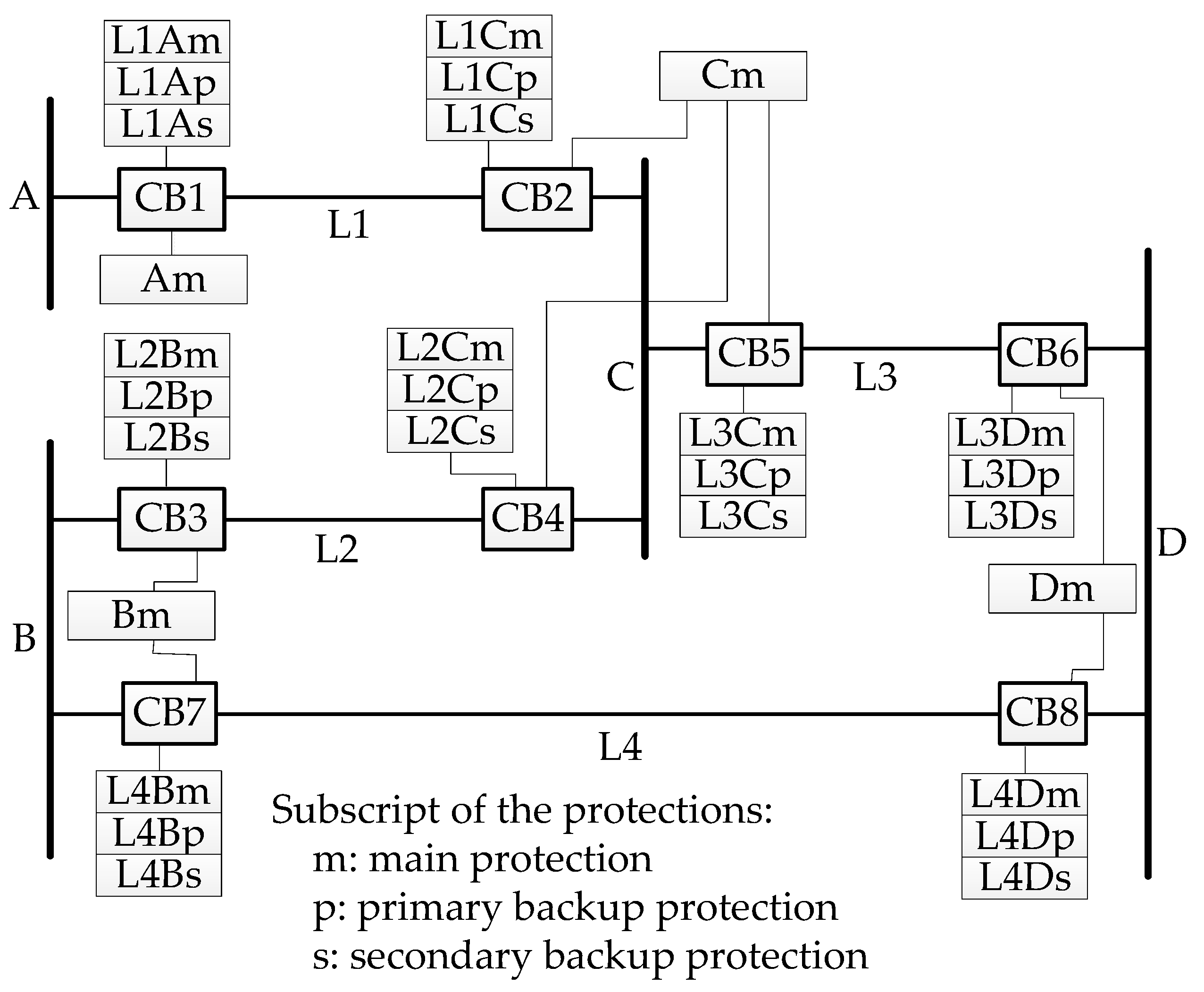
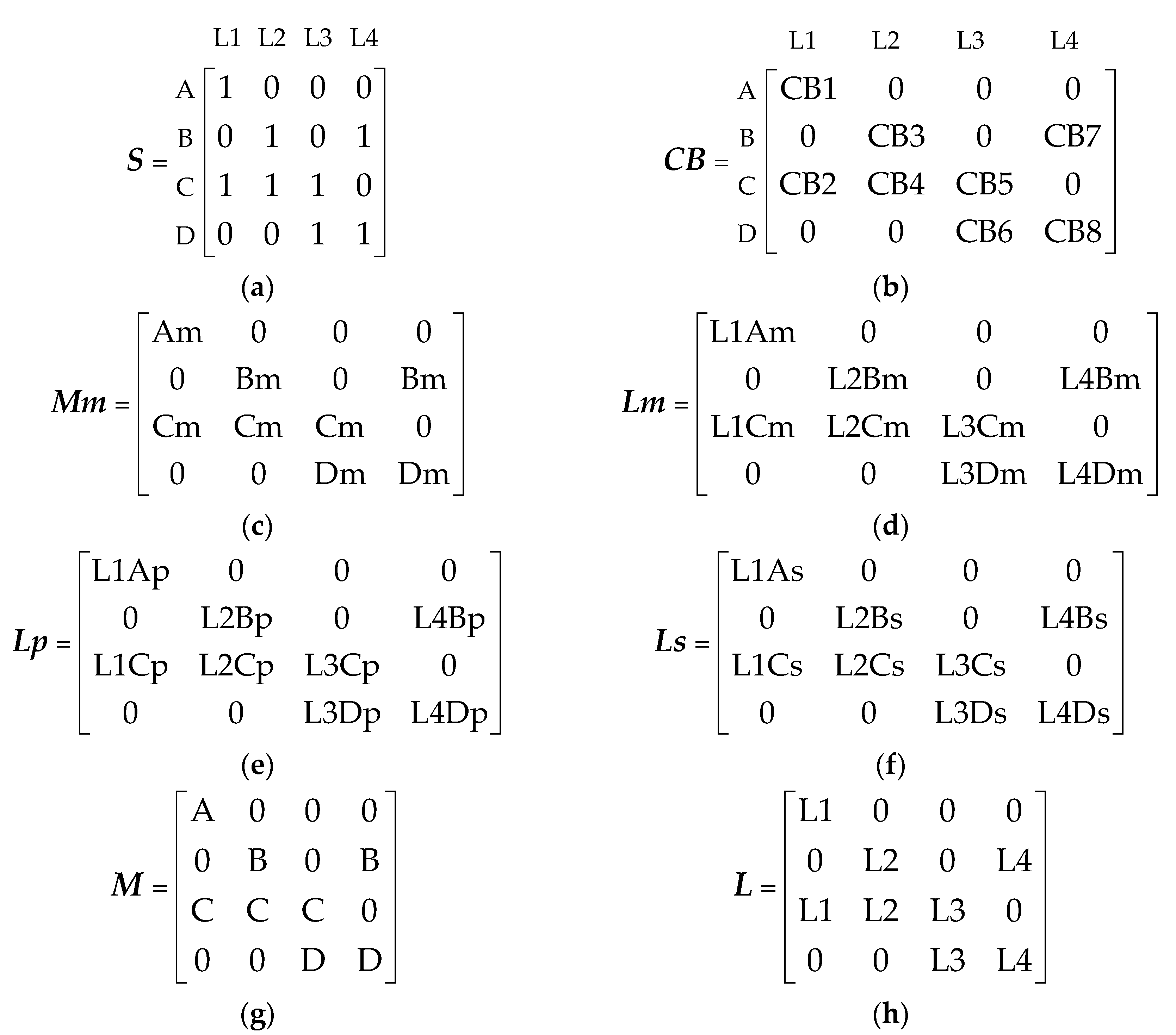
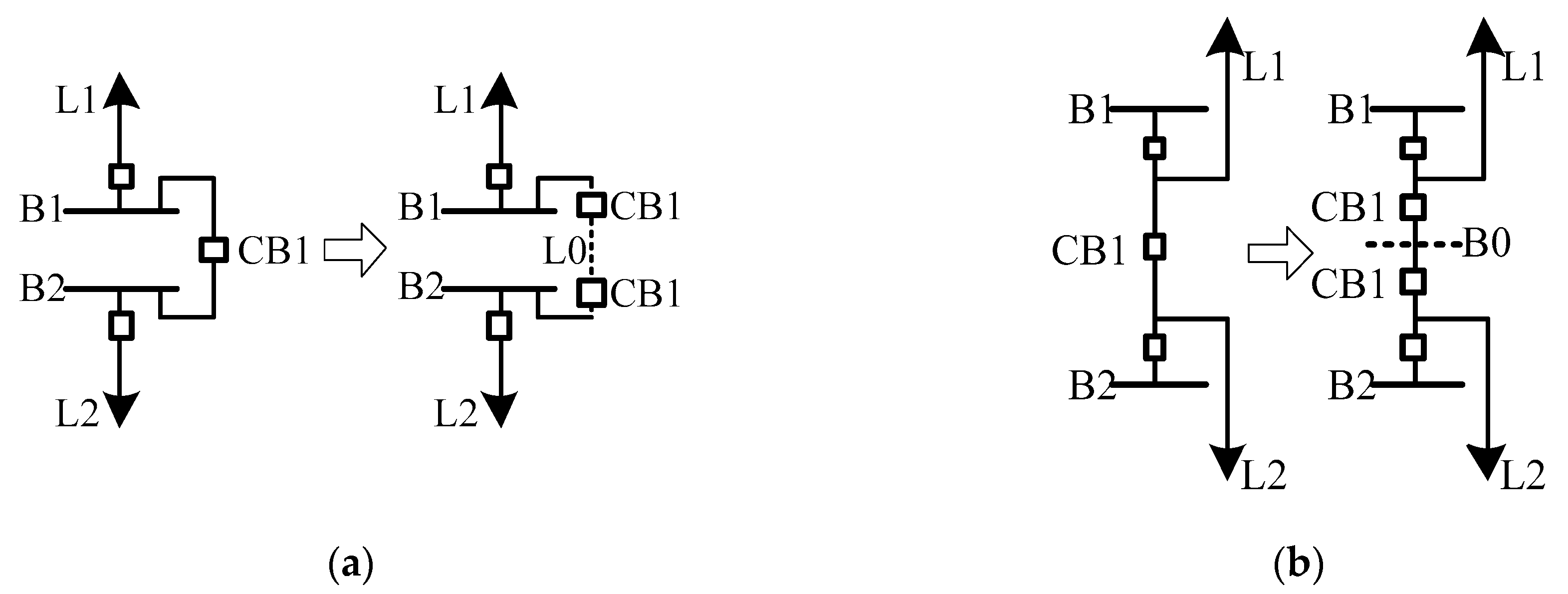
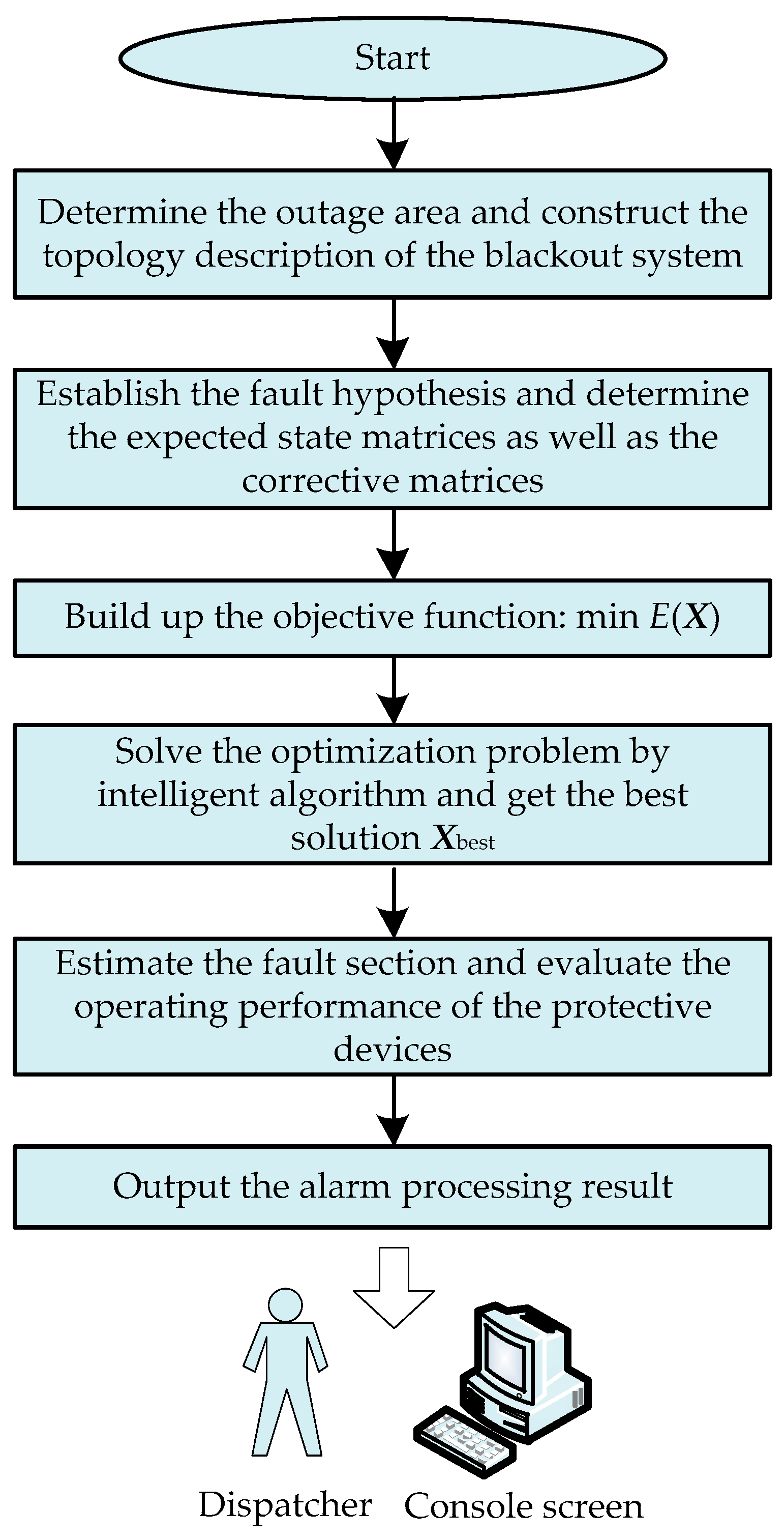
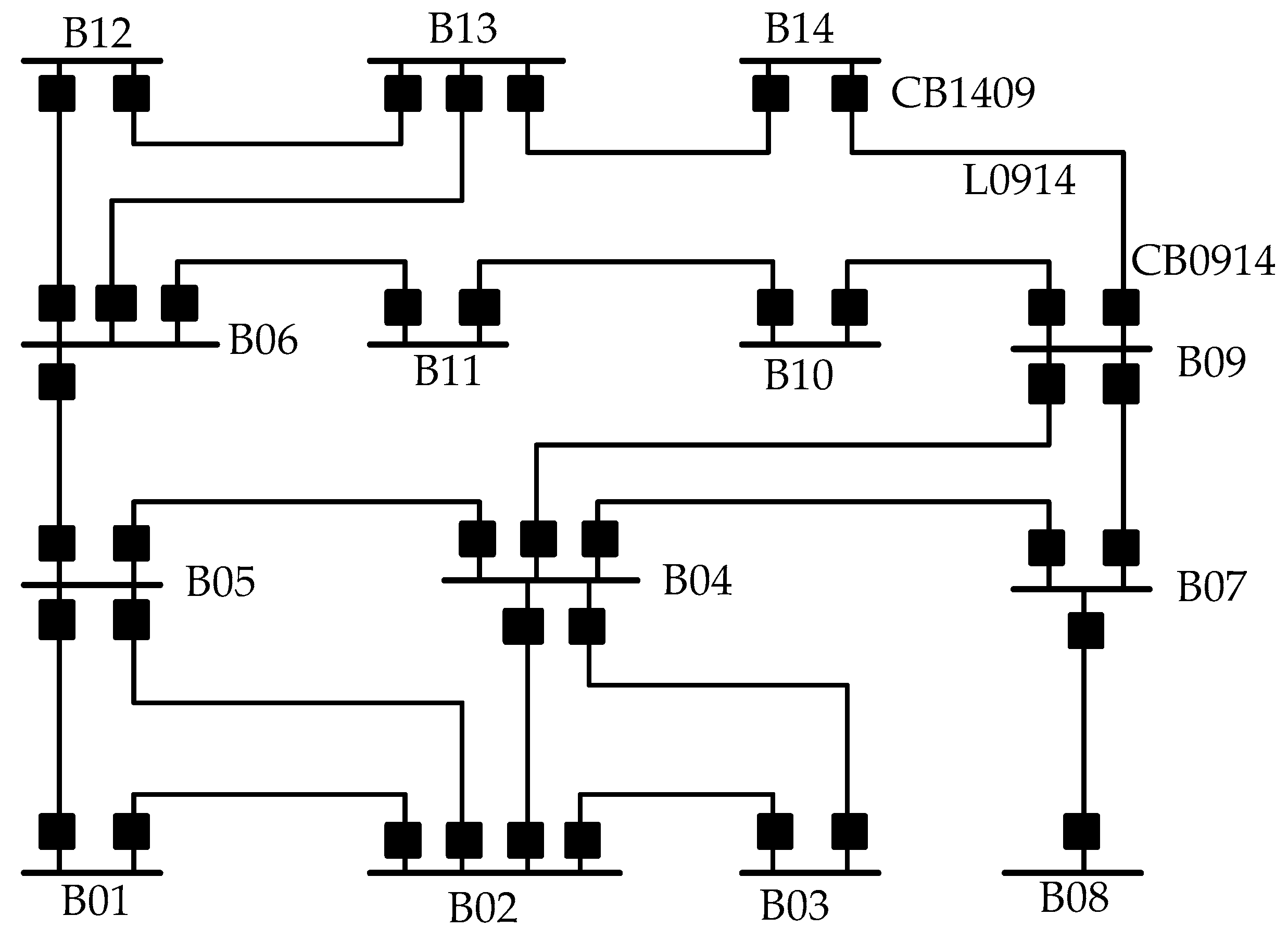
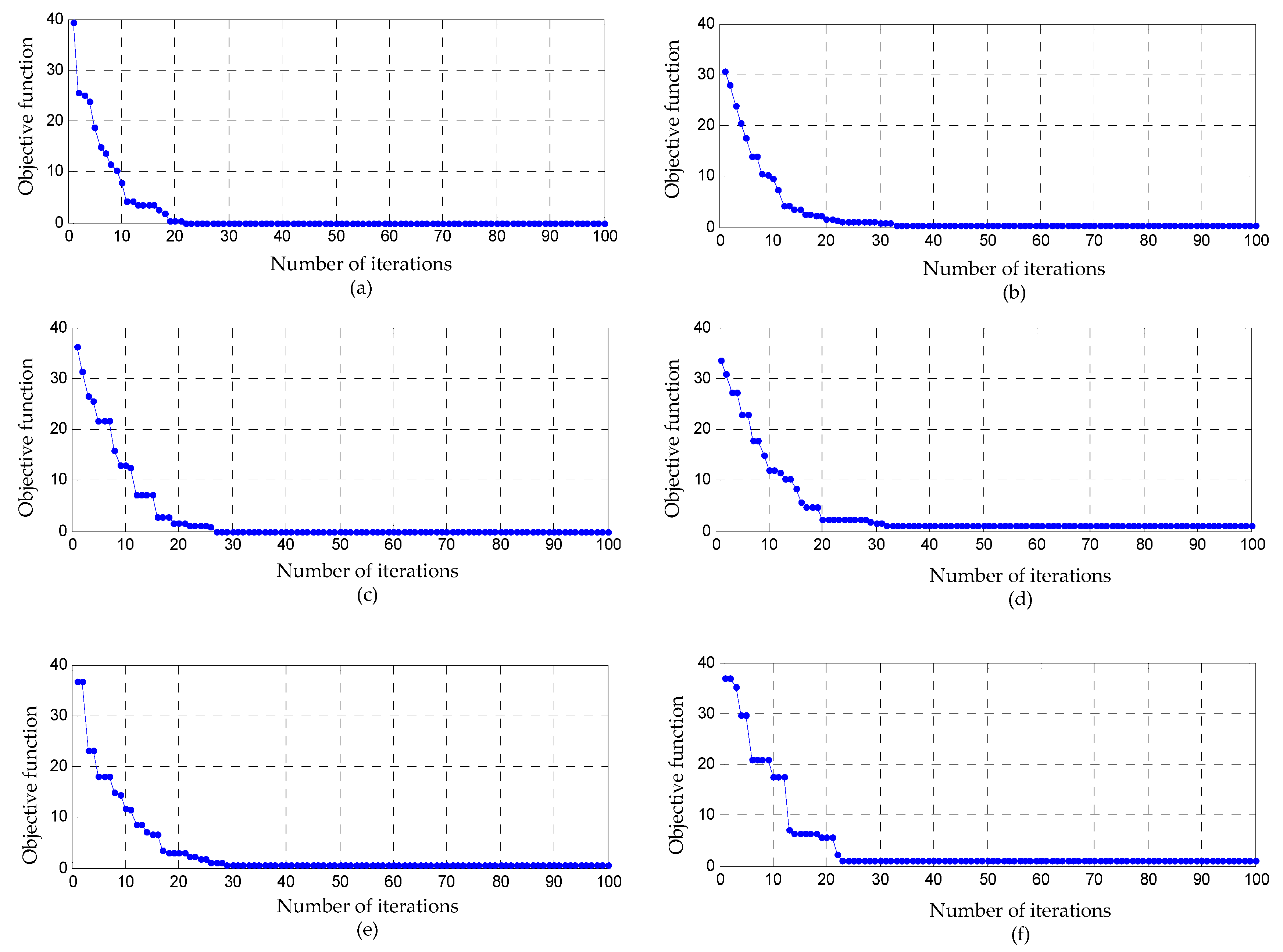
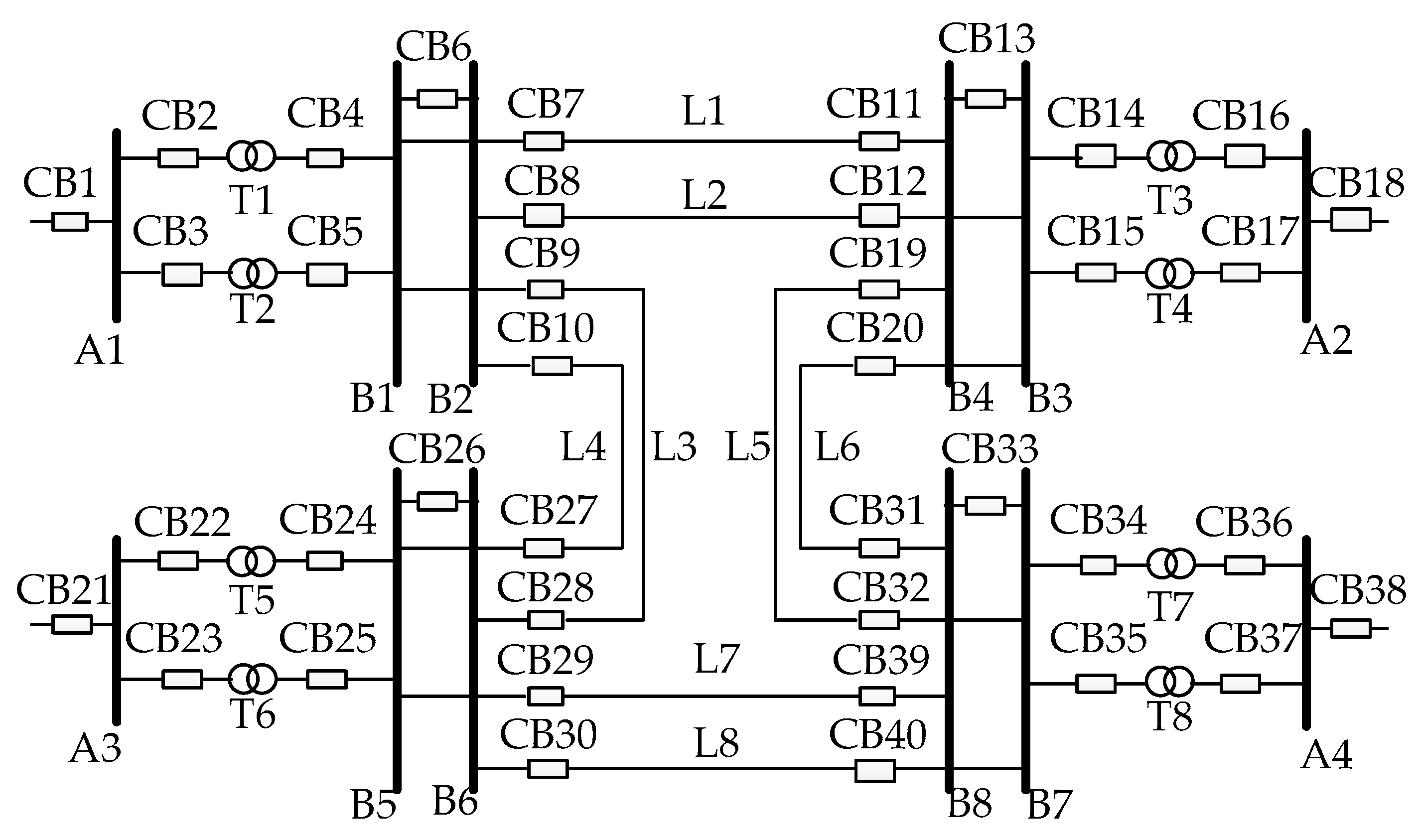
| NO. | Received Alarms | Fault Diagnosis Result | ||
|---|---|---|---|---|
| Fault Section | Evaluation | |||
| 1 | B13m, CB1312, CB1306, CB1314 | 0 | B13 | Normal |
| 2 | B13m, L1413p, CB1312, CB1306, CB1314 | 0.4 | B13 | L1413p (misreported) |
| 3 | B07m, L1011m, L0611s, CB0704, CB0709, CB0708, CB1011, CB0611 | 0 | B07 L1110 | L1110m (failed to operate) L1110p (failed to operate) |
| 4 | B07m, B10m, L1110s, CB0704, CB0709, CB0708, CB1110, CB1009, CB1106 | 1.2 | B07 B10 | CB1011 (failed to operate) CB1106 (mal-operated) |
| 5 | B11m, L0204m, L0402m, L1011s, CB1106, CB1011, CB0204, CB0402 | 0.6 | B11 L0204 | CB1110 (failed to operate) |
| 6 | L1011m, L1110m, B14m, L1314s, CB1011, CB1409, CB1314 | 1.0 | B14 L1110 | CB1110 (alarm missing) CB1413 (failed to operate) |
| NO. | Received Alarms | Fault Section of | Diagnosis Result of This Paper | ||
|---|---|---|---|---|---|
| [28] | [34] | Fault section | Evaluation | ||
| 1 | B1m, L2Rs, L4Rs, L7Sm, CB4, CB5, CB7, CB9, CB12, CB27, CB29 | B1 | B1 | B1 | CB6 (failed to operate) L7Sm (mal-operated) |
| 2 | T3p, L7Sp, L7Rp, CB14, CB16, CB29, CB39 | T3 L7 | T3 L7 | T3 L7 | L7Sm (failed to operate) L7Rm (failed to operate) |
| 3 | B1m, B4m, L1Sp, L1Rm, CB4, CB5, CB6, CB7, CB9, CB11 | L1 B1 B4 | L1 B1 | L1 B1 | L1Sm (failed to operate) B4m (misreported) |
| 4 | B2m, L1Sm, L1Rp, L2Rm, L2Sp, CB4, CB5, CB6, CB7, CB8, CB9, CB10, CB11, CB12 | B2 L1 L2 | B1 B2 L1 L2 | B1 B2 L1 L2 | B1m (alarm missing) L1Rm (failed to operate) L2Sm (failed to operate) |
| 5 | L1Sm, L1Rp, L2Sp, L2Rp, L7Sp, L7Rm, L8Rm, CB7, CB8, CB11, CB12, CB29, CB30, CB39, CB40 | L1 L2 L7 | L1 L2 L7 L8 | L1 L2 L7 L8 | L1Rm (failed to operate) L2Sm (failed to operate) L2Rm (failed to operate) L7Sm (failed to operate) L8Sm (alarm missing) |
| 6 | T7m, T8p, B7m, B8m, L5Sm, L5Rm, L8Sp, L8Rm, CB19, CB20, CB29, CB30, CB32, CB33, CB34, CB35, CB36, CB37, CB40 | L5 L8 B7 T7 T8 | L5 L8 B7 B8 T7 T8 | L5 L8 B7 B8 T7 T8 | T8m (failed to operate) L8Sm (failed to operate) CB31 (failed to operate) CB39 (failed to operate) L6Ss (alarm missing) L7Ss (alarm missing) |
© 2019 by the authors. Licensee MDPI, Basel, Switzerland. This article is an open access article distributed under the terms and conditions of the Creative Commons Attribution (CC BY) license (http://creativecommons.org/licenses/by/4.0/).
Share and Cite
Xu, B.; Yin, X.; Wu, D.; Pang, S.; Wang, Y. An Analytic Method for Power System Fault Diagnosis Employing Topology Description. Energies 2019, 12, 1770. https://doi.org/10.3390/en12091770
Xu B, Yin X, Wu D, Pang S, Wang Y. An Analytic Method for Power System Fault Diagnosis Employing Topology Description. Energies. 2019; 12(9):1770. https://doi.org/10.3390/en12091770
Chicago/Turabian StyleXu, Biao, Xianggen Yin, Dali Wu, Shuai Pang, and Yikai Wang. 2019. "An Analytic Method for Power System Fault Diagnosis Employing Topology Description" Energies 12, no. 9: 1770. https://doi.org/10.3390/en12091770
APA StyleXu, B., Yin, X., Wu, D., Pang, S., & Wang, Y. (2019). An Analytic Method for Power System Fault Diagnosis Employing Topology Description. Energies, 12(9), 1770. https://doi.org/10.3390/en12091770




